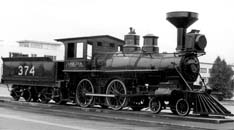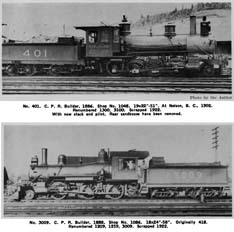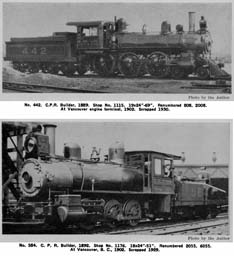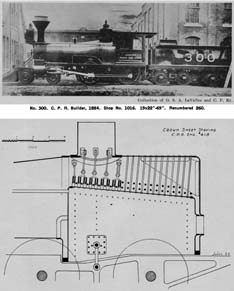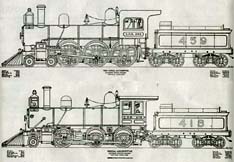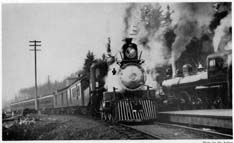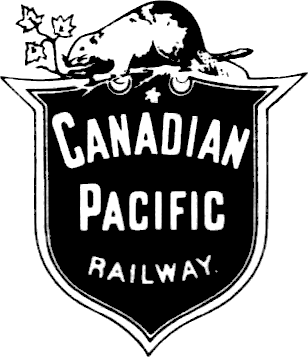
Home
Articles
Beginnings
Grouping
Canada
4-4-0
America
Sidebar
Brown
2-8-0
2-6-0
Crown Bars
Steel Cab
4-6-0
The Past
Notes
Credits
Background
Almost as soon as the steam locomotive had begun to take a more or less accepted pattern as to its essential parts, the men who designed and built it managed also to give their product something of their own individuality insofar as appearance went.
In its earliest days more attention was paid to making it a workable machine, but soon, at least in England, Locomotive Engineers, the equivalent of our Superintendents of Motive Power (SMP), began to see to it that their product became a thing of beauty, each according to his own standards.
This tendency reached its peak during the 1870s, 1880s, and 1890s of the last century and the engines that came from the shops or "works" of the many British lines of the day were, for beauty of line and proportion, clean surfaces unmarred by pipes and other attachments, distinctive paint jobs and fine finish, among the handsomest machines that ever travelled on rails.
Whether or not the railways of the British Isles built their motive power as well, or as economically as they could have bought it, is a question, for there were plenty of private builders in the country. At any rate all the large systems, and some of the smaller ones, went in for building their own, with the result that each developed and unmistakable set of external features such as stack, dome, cab, wheel splashers, and colour schemes, by which the merest tyro (novice) could recognize them.
Occasionally, when a motive-power head went from one line to another, the exterior appearance of his engines went with him, for these old timers had an artist's pride in their work, and each had his admiring and enthusiastic following.
Gradually this interesting phase of design began to feel the effects of two influences, one, the steady increase in the size of the locomotive, and the other, the two consolidations of British railroads, the first of which came in 1923, when most of them were grouped to form four main systems: London Midland & Scottish, London & North Eastern, Great Western, and the Southern. Then in 1948, came the consolidation of these four into a Government-owned and operated system known as British Railways, which has continued as such to the present day.
Now to our own country and what was taking place. For one thing we were more or less dependent on London and other European financial centers, and being poor, our railroads were for the most part, cheaply built, which meant grades, curvature, roadbed, and track that would not have been countenanced in the older countries. This in turn called for flexibility in motive-power and rolling stock, something very different to the more rigid types almost universal in Europe.
At first the U.S. and Canada imported a sizable number of locomotives from Britain, but their plate frames and rigid wheelbases were soon found to be unsuitable for use on American track.
As a rule our roads got along without more than maintenance facilities, leaving the building of their power to one or more of the many locomotive works that sprang up to fill the demand in the rapid expansion that was to continue for three decades or more.
Early in the game a definite "American" type emerged, the "Eight-Wheel", or as it was often familiarly called, "Standard" engine. This, and outside cylinders, bar-framed machine, with four coupled drivers and a leading four-wheeled truck, was to be maid-of-all-work on the roads of this continent for many years, and was still very much in the picture in passenger service up to 1900.
Where the Britisher left the design and building of his locomotives mainly in the hands of the company's Locomotive Engineer, we on our side of the pond, turned to Baldwin, Rogers, McQueen, Blood, Mason, Brooks and a host of others. In fact, competition was so keen that the railroads simply couldn't afford to build their own power, and with a few exceptions, this state of affairs has continued right down to the ousting of the American steam locomotive by the Diesel.
Among the larger systems which undertook the building of part of their own power were the Pensylvania Railroad (PRR) at Altoona, the Union Pacific (UP) at Omaha, the Southern Pacific (SP) at Sacramento, the New York Central (NYC) at Albany, and last but by no means least, the Canadian Pacific Railway (CPR) at Montreal.
Theodore N. Ely, of the Pennsylvania, probably turned out more engines than any other American SMP. With their capped stacks, smooth dome, sandbox covers, and rounded cab corners they were typically PRR. Joseph McConnell, who revamped the UP's haphazard motive power department of the 1890's, developed a style that stood out because of a number of features including his distinctive diamond stacks. A.J. Stevens, General Master Mechanic at Sacramento, left the beaten track with his long-stroke cylinders, power reverse gear, "Monkey" motion, and unusual form of boiler. And who hasn't admired William Buchanan's NYC eight-wheel engines of the early 1890's? Numbered in the 700s and 800s, they were among the finest looking and fastest of their day. They had track to match, and on that track the 999 set her memorable record. The Central's genial Passenger Agent, George H. Daniels, was not one to sit back when publicity material of this caliber presented itself, and soon everyone in the country heard of his road and its famous engine.
Francis Robert Fountaine Brown was the man. Born in Helensburgh, Dumbartonshire, Scotland, on 29 Sep 1845, Brown belonged to that pioneering generation of engineers who learned their profession on the job, and not in a university. He was apprenticed "as a pupil in the shops and drawing office of the Great Northern Railway at Doncaster, England," from 1863-1868, and later employed by the same railway at various places on its system until 1874. In his later years he was stationed at London, which may have given him the contacts for his next adventure. Whatever the reason, he did boldly try a new setting for his skills, by accepting an appointment in 1874 on the Great Indian Peninsula Railway. This was one of the first great trunk lines in India, with rails reaching across the subcontinent from a base in Bombay. Brown increased his responsibilities in India until the hot season of 1876 struck him down:
"When riding on the engine accompanying the new Viceroy, Lord Lytton, over my division I contracted a sun-stroke followed later by Typhoid fever which compelled my return to England in August 1876 for Medical treatment."
His bout with the climate of India did not end his interest in working abroad, but it did turn him in a new and cooler direction, Canada.
In 1877 he took a new position as manager of the Grand Trunk Railway's Point St. Charles shops in Montreal, the principal shop faculties of what was then Canada's premier railway.
"I joined the G.T.Ry. service in Canada in May 1877. Remaining in the service of that Coy. as Loco Works Manager at Point St. Charles till July 1883. During which time I built over 100 (one hundred) new Locomotives for that Coy., which were of the Mogul, Heavy Passenger, Suburban, and Switching types."
This experience enabled Brown to become thoroughly familiar with the Canadian variations on British railway engineering practice.
In July 1883 Francis Brown got his chance to be the boss himself with his new appointment as Mechanical Superintendent for the Canadian Pacific Railway. Here he had a wider range of duties and responsibilities, but included among them was the responsibility for motive power. Brown finally got a chance to design and build locomotives according to his own ideas. He did this with great success. But to round out his career, so far as we know it, he did not stay long with the Canadian Pacific. He resigned in July 1889 to take a similar position with Dominion Bridge in Lachine, Quebec. From there he moved in November 1891 to Toronto as general manager of the Ontario Forge and Bolt Co., and in 1892 he went to Moncton, New Brunswick, as mechanical superintendent of the Intercolonial Railway. Interested researchers have not yet found any further record of this remarkable man.Fritz Lehmann - "CPR No. 374 and Francis R.F. Brown" - British Columbia Historical News volume 20, No. 2, Spring 1987 (exerpt).
Comes now Francis R.F. Brown, the first and almost forgotten Chief Mechanical Engineer of a great system, the CPR, and who, in the approximately ten years of his tenure of office, built over 150 locomotives. Yet, insofar as the company's Staff Records Department is concerned, he is apparently non-existent. It has been told the writer that the department stands pat on its statement that, since it has no staff record, Mr. Brown could not, officially, have worked for the company. This is an amazing thing. If a ghost, Mr. Brown must have materialized for quite some time, for he left many signed drawings in the Mechanical Department, and much other tangible evidence in the shape of real honest-to-goodness locomotives. This situation may have its roots in the fact that high brass had ordered certain Motive Power Department records (prior to 1900) destroyed. Strangely, too, search of the early files of the Montreal papers, when the first company-built engine was turned out of the then new DeLormier Avenue shops, reveals no mention of either the 285 or of Mr. Brown.
Though it's difficult to find much Motive Power Department information prior to 1900, we do know that the company-built locomotives of the period from 1885 to about eight years later were as distinctively "Brown" as ear-marks could make them. The several illustrations herein show very plainly the characteristic features, that in his mind at least, constituted a good-looking locomotive.
In 1886 Brown designed the first company-built Consolidations, four of which, 401-404, were turned out that year, and two, 405-406, in 1887. Four Baldwin 2-8-0s preceded them, these being used in helper service out of Field and Revelstoke. The first CPR-built 2-8-0, the 401, is shown in almost her original condition in the accompanying photo taken by the writer at Nelson, BC, in 1902. This class had 19 x 22 inch cylinders and 51 inch drivers. Of the total weight of 104,000 pound, 90,000 pounds was adhesive. They carried 160 pounds of steam, quite high for the day, and were fitted with large sandboxes beneath the cab, for running tender first. These were eventually removed. As to external appearance they represent a midway point between Brown's earlier and later engines.
On 16 May 1887 Mr. Brown read a paper before the Institute of Locomotive Engineers, when that august body met in session at London, England. This was a lengthy description of the different classes of locomotives he had designed for the CPR and the Canadian climate, and considerable discussion relative to their merits and short-comings was indulged in, partly due to the radical differences in British and American power. The report and comments on it make interesting reading, and can be found in the Railroad Gazette of 17 Jun 1887.
About this time he designed the Moguls (shown in one of the larger drawings) of which the Company built some fifty at its Montreal shops. The 418 was one of these, an 18 x 24 inch cylindered engine with 57 inch drivers carrying 87,000 pounds of her total weight of 100,000 pounds. Aside from their wheel arrangement and wooden cabs, the engines of this class were much like other Brown engines of following years, clean lines, smooth domes, and sandboxes, no outside pipes to mess up their appearance, and a neat capped stack which was itself something out of the ordinary, in that its lining, or inner stack, instead of having the choke near the base, was contracted at the top. Though decidedly unusual, this arrangement seems to have given good results, for the engines proved to be free steamers.
Other deviations from accepted practice was the 180 pound pressure, when it was usual to set pops at 160 pounds, the use of Gresham & Craven injectors, a popular British make, mounted on the boiler head and delivering feed through a pipe extending inside, and over the crown sheet, to the forward end of the boiler. Another unusual feature, one used by Brown in many of his engines, was the method of staying the crown sheet. While this may have been used before, the writer has never come across an example of this kind in connection with the conventional type of boiler, at least not on an American road.
While crown bar and radial stays were both in general use, the latter finally becoming almost universal, Brown supported the forward part of the crown sheet by from four to seven pairs of crown bars, and from these to the back end of the firebox, by direct radial stays. This enabled the placing of the dome directly over the firebox, and according to the designer, did away with excessive strain due to expansion of the forward end of the firebox when firing up.
Engine 418, built in 1888, finally became the 3009 shown in the photograph taken after the 1812 renumbering. She was scrapped in 1922. Engines of this class were used pretty much over the entire system, but no more were built, as 4-6-0s took over the work.
In 1889, Mr. Brown designed and built at the company shops two 10-wheel engines, somewhat in the nature of an experiment, to handle high-speed passenger service between Canada's largest two cities, Montreal and Toronto. This design was interesting on several counts. The 456 and 459 had the largest 6-coupled drivers, 75 inches, in Canada, up to that time a very short wheelbase, 22 feet 11 inches, less than that of many an 8-wheeler (the standard UP 4-4-0s of the day had a 24 foot 9 inch wheelbase), the front tires were blind, and with a six-inch face, so that the engine might curve easily, cylinders of short stroke, 22 inches, kept piston speed down, and side-rods were forged with solid eyes and with oil cups integral.
A handsome steel cab was furnished, the first on the road, possibly the first on a large American main line.* Cab rivets were countersunk and finished flush, as were the front-end rivets, to make a smooth job, while a 1 1/2 inch air space was provided between the outer steel and the wooden cab lining.
* During the 1850s, several engines were built by Norris to the designs of James Millholland, Master of Machinery, of the Philadelphia & Reading. These engines had round-cornered cabs, whose outer surface was apparently of sheet metal. They were illustrated in Locomotive Engineering of May 1896. (F.J.)
The 54 inch boiler was similar to that of the Mogul in that the crown sheet was stayed both radially and with crown bars, and carried 180 pounds pressure. The total weight was 107,000 pounds, of which 84,000 pounds were on the drivers. Given shop numbers 1106 and 1117, they became 800 and 801 in the 1905 renumbering.
This design was not perpetuated, due probably to the fact that, while they could run fast enough, they couldn't get a heavy train out of town as quickly as the smaller-wheeled engines. So, in 1912, they were fitted with 18 x 24 inch cylinders and 63 inch drivers, presumably a more satisfactory combination.
Given the road numbers 267 and 268, they ran until scrapped, the 267 in 1916, and the 268 in 1933, so our old 459 had a useful life of forty-four years.
Another Brown engine is the 442, photographed at the Vancouver engine terminal in 1902, after her westbound passenger run from Kamloops. As shown the engine has a new stack, Pyle-National headlight, and MCB couplers. In the photograph of the meet at Mission Junction, BC, the 442 is shown at the right with her westbound transcontinental train, while her sister engine 441, with the Vancouver-Seattle train heads south from the main line, the latter with her original large headlight. These two were 19 x 24 inch engines with 69 inch drivers, and were built at the company shops in 1889.
Engine 584 was photographed at the Vancouver roundhouse in 1902. This engine, which has the familiar Brown characteristics, was built at Montreal and carries the company plate on the steam chest, construction number 1176 of 1892. The road number was later changed to 2055. We notice, too, that the conventional type of injector, with its outside delivery, is used.
The old diamond stacked 300 was the second with that number. One of Brown's earlier designs of 1884, this 19 x 22 machine had 69 inch drivers and was intended for fast passenger work. The influence of British design shows in the clean boiler, the deck-level running boards, and sandboxes on top of the latter. This neat little diamond stacker was scrapped in 1931.
These old Brown engines are now a thing of the past, along with the day when a 4-4-0 engine could be bought for from $8,000 to $10,000, steel rails at $28.00 a ton, when sixteen locomotive builders advertised their wares in the pages of the Railroad Gazette, when engine and train crews were paid by the trip, whether it took four or twenty-four hours to get over the division, when the engineer was expected to make emergency repairs out on the road, and the fireman was required to keep everything above the running board bright and shining, which of course, included boiler head and cab interior, and another important item, the polishing of the headlight reflector.
The only small dark cloud in the offing was the possible inroad of electricity via trolley wire or third rail. No one dreamed of the Diesel, but it came in like a lion, and just in time to save many an American railroad from financial deep water. But to those of us who knew the steam locomotive of sixty-years-ago, there has come the feeling that something very rich has gone out of our lives.
Editor's Note: Thanks to the efforts of Robert R. Brown, our Canadian Representative, we are able to add a few facts concerning the career of the late Francis R.F. Brown:
Sep 1874 - Assistant locomotive and car superintendent at Egutpoora on the Great Indian Peninsula Railway.
Jan 1875 - Superintendent of motive power and rolling stock at Jubbulpoor, Great Indian Peninsula Railway.
Aug 1876 - Left India.
Apr 1877 - Works Manager at Point St. Charles, Montreal on the Grand Trunk Railway.
1 Jul1883 - Mechanical Superintendent of the Canadian Pacific Railway, Montreal.
His departure from the CPR is unknown. Old drawings and reports exist bearing his signature through the end of 1888 and it seems likely that he made his departure in 1890. At any rate, during the years that he was with the CPR he built over 150 locomotives with distinctive characteristics, and they were handsome because they followed straight and simple lines.
Fred Jukes - Some Early Brown Locomotives on the CPR, The Railway and Locomotive Historical Society Bulletin No.97 (October, 1957), pages 21-26, published by the Railway & Locomotive Historical Society (R&LHS).
Canadian Pacific Railway Imperial Limited - 1890 Photographer?


